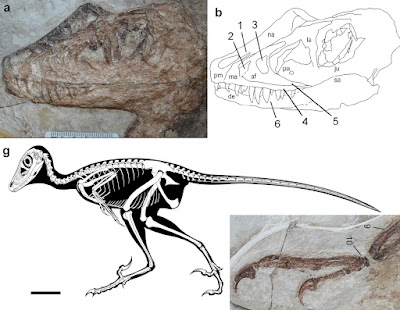 |
| Daurlong wangi Wang, Cau, Guo, Ma, Qing & Liu, 2022 |
Abstract
Dromaeosaurids were bird-like dinosaurs with a predatory ecology known to forage on fish, mammals and other dinosaurs. We describe Daurlong wangi gen. et sp. nov., a dromaeosaurid from the Lower Cretaceous Jehol Biota of Inner Mongolia, China. Exceptional preservation in this specimen includes a large bluish layer in the abdomen which represents one of the few occurrences of intestinal remnants among non-avian dinosaurs. Phylogenetically, Daurlong nests among a lineage of short-armed Jehol Biota species closer to eudromaeosaurs than microraptorines. The topographic correspondence between the exceptionally preserved intestine in the more stem-ward Scipionyx and the remnants in the more birdlike Daurlong provides a phylogenetic framework for inferring intestine tract extent in other theropods lacking fossilized visceral tissues. Gastrointestinal organization results conservative among faunivorous dinosaurs, with the evolution of a bird-like alimentary canal restricted to avialan theropods.
Systematic palaeontology
Dinosauria
Theropoda
Dromaeosauridae
Daurlong wangi gen. et sp. nov.
Holotype IMMNH-PV00731, an almost complete dromaeosaurid (Figs. 1, 2, Supplementary information).
Locality and Horizon: Pigeon Hill, Morin Dawa Daur Autonomous Banner, Inner Mongolia Autonomous Region (N 48°39′40.76″/E 123°52′ 41.15″); Longjiang Formation, Lower Cretaceous.
Etymology: The genus name is derived from the Daur Nation, and the Chinese 龙 ("lóng") for "dragon". The species name honors Mr. Wang Junyou, director of the IMMNH.
Diagnosis: Mid-sized dromaeosaurid with (autapomorphies marked by asterisk): slender subnarial ramus of premaxilla extended caudally well beyond the external naris; large, trapezoid promaxillary recess placed at the rostroventral corner of antorbital fossa*; maxillary fossa large, shallow and caudodorsally located, so that the pila promaxillaris is wider than the pila interfenestralis*; stepped transition from the subcutaneous surface of maxillary ventral ramus to the antorbital fossa; fan-shaped distal end of first sternal rib*. Differential diagnosis: Daurlong further differs from Tianyuraptor because it bears longer and more robust maxillary teeth and a more robust ulna. Daurlong further differs from Zhenyuanlong because it lacks a pitted ventral ramus of the antorbital fossa, lacks markedly concave distal margins in maxillary tooth crowns, bears a bowed scapula, a more robust radius, and a wider overlap of the semilunate carpal over metacarpal II (Fig. 3).
Xuri Wang, Andrea Cau, Bin Guo, Feimin Ma, Gele Qing and Yichuan Liu. 2022. Intestinal Preservation in A Birdlike Dinosaur supports Conservatism in Digestive Canal Evolution Among Theropods. Scientific Reports. 12, 19965 DOI: 10.1038/s41598-022-24602-x







